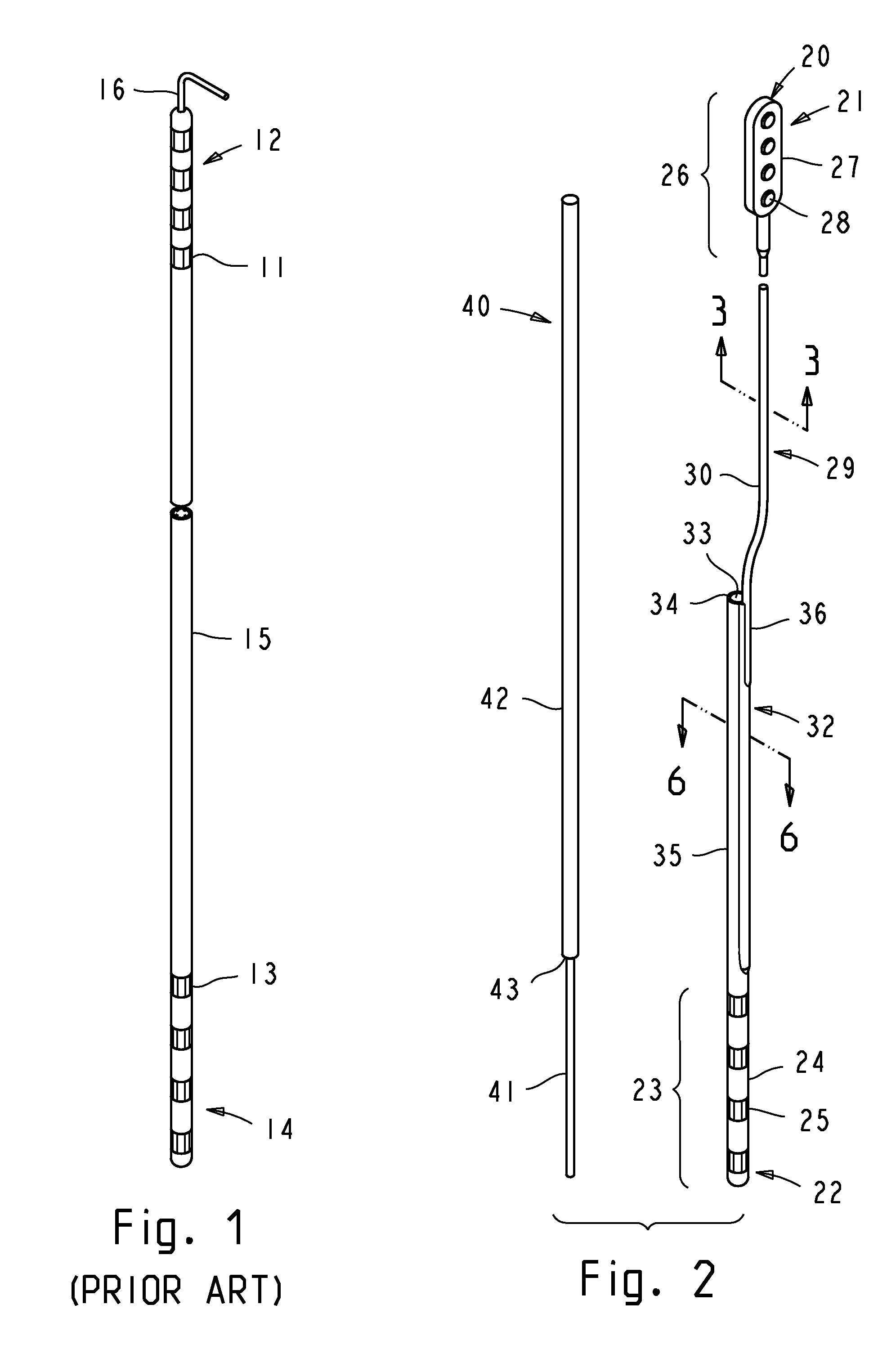Implantable lead and accessories
a technology of lead and accessories, applied in the field of implantable lead and accessories, can solve the problems of increasing limiting the options of the proximal end of the connector, and the general inability to manufacture paddle-shaped connectors, etc., to achieve the effect of reducing the flexing of the distal end of the lead, facilitating robust small-dimensioned electrode terminals, and reducing the risk of brain injury or hemorrhag
- Summary
- Abstract
- Description
- Claims
- Application Information
AI Technical Summary
Benefits of technology
Problems solved by technology
Method used
Image
Examples
embodiment 60
[0150]In FIG. 11, a cable embodiment 60 has a wavy form and is encased in casing 61. As shown in FIG. 12A, cable body 62 can have a smaller outside diameter and conductors 31 can be closer together than in the straight cable 29 of FIG. 3, since the additional service length is provided by the waviness of the cable.
[0151]The wavy form can be sinusoidal, helical, irregular, or any combination that can provide an additional axial service length within the casing, allowing the cable to have stretchability in service. Such stretchability allows accommodation of movement and or tissue dislocation (e.g., due to atrophy or growth), and thus prevents build up of axial tension in the lead which could cause lead dislodgement.
[0152]The waviness may be imparted to cable body 62 by molding, heat forming, or other methods. A thermosetting insulation material, such as silicone rubber, can be molded to a wavy shape while in a green (uncured) state and subsequently cured. In the case of a thermoplast...
embodiment 66
[0154]FIG. 12 B shows a wavy cable embodiment 66 having a ribbon configuration. Insulation 67 can be co-extruded onto either bare or pre-insulated conductors 31. The flattened cross-sectional profile facilitates merging of cable 66 into the sheath at 36.
[0155]FIG. 13 is another embodiment of a cable, having conductors 31 helically wound around an elastomeric core 68 and placed in an insulating sleeve 69.
[0156]FIGS. 14 and 15A-B show an embodiment of a small-dimensioned electrode terminal 70 with closely spaced electrodes 71. Such small-dimensioned electrode terminal is desirable for implantation in a small and / or dense anatomical target where high spatial resolution is required for electrode localization. As a non-limiting example, the electrode terminal's diameter may be 1.0 mm, the electrode's length may be 1.0 mm, and the electrode pitch may be 2.0 mm. The sheath's construction and size can be substantially the same as in lead 20. The electrode material can be platinum, platinum / ...
embodiment 130
[0183]FIG. 28 is a perspective view of a lead embodiment 130 shown side-by-side with a stylet 131. The lead comprises a high resolution electrode terminal 132, a tubular sheath 133, cable 29 and connector terminal 26. Multi-conductor cable 29 enters sheath 133 through an opening 134 and extends inside the sheath opening toward electrode terminal 132.
[0184]Stylet 131 has a slot 136 to accommodate the centrally disposed cable 29. The most distal portion 137 of the stylet's slotted portion has an arcuate cross-section formed by counter-boring the distal end of the stylet. The arcuate portion 137 of the stylet is designed to engage a stiffening tube 138 extending into the sheath from the electrode terminal (FIG. 32).
[0185]FIGS. 29 and 30 are cross-sectional views of lead 130, with stylet 131 installed, taken at different depths of the sheath. The cross-section of FIG. 29, taken adjacent to the sheath opening 134 shows the slotted portion of the stylet in retentive contact with the sheat...
PUM
 Login to View More
Login to View More Abstract
Description
Claims
Application Information
 Login to View More
Login to View More - R&D
- Intellectual Property
- Life Sciences
- Materials
- Tech Scout
- Unparalleled Data Quality
- Higher Quality Content
- 60% Fewer Hallucinations
Browse by: Latest US Patents, China's latest patents, Technical Efficacy Thesaurus, Application Domain, Technology Topic, Popular Technical Reports.
© 2025 PatSnap. All rights reserved.Legal|Privacy policy|Modern Slavery Act Transparency Statement|Sitemap|About US| Contact US: help@patsnap.com



